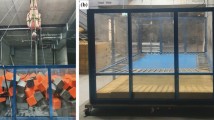Abstract
Rope systems are simple mechanical structures that provide life-critical protection from dynamic loading in a variety of applications where falls from height are possible. Recently, the Fire Service has realized the importance of using fall protection systems while endeavoring to gain a better understanding of how these systems will respond during fire ground deployments. A new extensometer, utilizing a linear variable differential transformer, was designed to advance the ability to characterize the dynamic and static properties of these ropes. A series of experiments were conducted to replicate various deployment scenarios, quantifying the effect of fall height, payout length, and ledge geometry on the dynamic loads a firefighter and his/her equipment may expect in realistic escape scenarios utilizing common rope systems. These loads are compared to occupational health-safety-based maximum load recommendations and the quasistatic strength of the rope. While the ropes constructed from all aramid fibers were the strongest in standard quasistatic tests; during dynamic loading they generated the largest maximum arrest loads that were consistently above the occupational health-safety recommended load of 8 kN. Finally, using the experimentally determined rope properties measured with the new extensometer, positive agreement was found between the experimental drop tests and numerical simulations.
Similar content being viewed by others
References
NIOSH Firefighter Fatality Investigation and Prevention Program. “Career Lieutenant and Career Fire Fighter Die and Four Career Fire Fighters are Seriously Injured during a Three Alarm Apartment Fire—New York” (2006).
Schad, R., “Analysis of Climbing Accidents,” Accident Analysis and Prevention 32(3): 391–396 (2000).
Lionel, M., Matthieu, R., Jarir, M., and David, J., “Modeling the Climber Fall Arrest Dynamics,” ASME International Design Engineering Technical Conferences and Computers and Information in Engineering Conference, Long Beach, CA, 6 B, pp. 1077–1084 (2005).
Pavier, M., “Experimental and Theoretical Simulations of Climbing Falls,” Sports Engineering 1(2): 79–91 (1998).
Baszczyński, K., “Dynamic Strength Tests for Low Elongation Lanyards,” International Journal of Occupational Safety and Ergonomics 13(1): 39–48 (2007).
Vogwell, J., and Minguez, J.M., “The Safety of Rock Climbing Protection Devices Under Falling Loads,” Engineering Failure Analysis 14(6): 1114–1123 (2007).
Baszczyński, K., and Jachowicz, M., “Effect of Mechanical Factors on the Protective Parameters of Textile Elements in Personal Equipment Protecting Against Falls from a Height,” Fibres & Textiles in Eastern Europe 19(5): 117–124 (2011).
Magdefau, H., Die Belastung des Meschlichen Korpers Beim Sturz ins Seil und Deren Folgen, Luwig-Maximilians-Universitat, Munich (1989).
Goh, Y.M., and Love, P.E.D., “Adequacy of Personal Fall Arrest Energy Absorbers in Relation to Heavy Workers,” Safety Science 48(6): 747–754 (2010).
Cordage Institute. “CI 1801–07 Low Stretch and Static Kernmantle Life Safety Rope” (2007).
NFPA 1983, Standard on Life Safety Rope and Equipment for Emergency Services, National Fire Protection Association, Quincy, MA (2006).
Davies, P., Baizeau, R., Grosjean, F., and Francois, M., “Testing of Large Cables for Mooring Line Applications,” Proceedings of the 1999 Ninth International Offshore and Polar Engineering Conference, Brest, France, pp. 369–376 (1999).
Chailleux, E., Forest, B., and Davies, P., “Identification of Model Parameters for Predicting Long Term Behaviour of Marine Ropes,” Oceans 2005-Europe, Brest, France, 2, pp. 1279–1285 (2005).
Abrate, S., Dooley, R., Kaste, R., Thibault, G., and Millette, W., “Nonlinear dynamic behavior of parachute static lines,” Composite Structures 61(1–2): 3–12 (2003).
Hennessey, C.M., Pearson, N.J., and Plaut, R.H., “Experimental snap loading of synthetic ropes,” Shock and Vibration 12(3): 163–175 (2005).
Bitting, K., The Dynamic Behavior of Nylon and Polyester Line, United States Coast Guard Research and Development Center, Avery Point, CT (1980).
Parsey, M., Street, A., and Banfield, S.J., “Dynamic Behavior of Marine Hawsers,” Seventeenth Annual Offshore Technology Conference, Houston, TX, 3, pp. 429–443 (1985).
Parsey, M., Hawkins & Tipson Ropemakers Ltd., “Fatigue of SPM Mooring Hawsers,” Fourteenth Annual Offshore Technology Conference, Houston, TX, pp. 71–94 (1982).
Wu, H.C., “An Energy Approach for Rope-strength Prediction,” Journal of the Textile Institute 83(4): 542–549 (1992).
Spierings, A.B., Henkel, O., and Schmid, M., “Water absorption and the effects of moisture on the dynamic properties of synthetic mountaineering ropes,” The International Journal of Impact Engineering 34(2) (2007).
Drabble, F., and Brookfield, D.J., “Safety of Fall Arrest Systems: A Numerical and Experimental Study,” Proceedings of the Institution of Mechanical Engineering, Part C: Journal of Mechanical Engineering 214(10): 1221–1233 (2000).
Obstalecki, M., Chaussidon, J., Kurath, P., and Horn, G.P., “Prediction of Dynamic Forces in Fire Service Escape Scenarios,” Proceedings of the 2011 SEM Annual Conference and Exposition, Uncasville, CT, 1, pp. 179–186 (2011).
Vines, T., and Hudson, S., High Angle Rescue Techniques, 3rd Edition, Elsevier Mosby-Jems, St. Louis, MO (2004).
OSHA 29 CFR Parts 1910 and 1926 Safety Standards for Fall Protection in the Construction Industry; 1926.502, “Fall Protection Systems Criteria and Practices,—section (d) Personal Fall Arrest Systems,” URL http://www.osha.gov/pls/oshaweb/owadisp.show_document?p_table=STANDARDS&p_id=10758[accessed 26 March 2013].
Sulowski, A.C., “How good is the 8kN Maximum Arrest Force limit in industrial Fall Arrest Systems?” International Symposium on Fall Protection, Seattle, WA (2006).
NFPA 1983, Standard on Life Safety Rope and Equipment for Emergency Services, National Fire Protection Association, Quincy, MA (2012).
UIAA Safety, “UIAA 101, Mountaineering and Climbing Equipment ‘Dynamic Ropes’,” Switzerland, URL www.theuiaa.org [accessed 5 May 2013].
Horn, G., Kurath, P., “Failure of Firefighter Escape Rope under Dynamic Loading and Elevated Temperatures,” Conference Proceedings of the Society of Experimental Mechanics Series, Indianapolis, IN, 1, pp. 353–359 (2011).
Author information
Authors and Affiliations
Corresponding author
Rights and permissions
About this article
Cite this article
Martin, D.A., Obstalecki, M., Kurath, P. et al. An Approach for Quantifying Dynamic Properties and Simulated Deployment Loading of Fire Service Escape Rope Systems. Exp Tech 40, 367–379 (2016). https://doi.org/10.1007/s40799-016-0041-9
Published:
Issue Date:
DOI: https://doi.org/10.1007/s40799-016-0041-9




